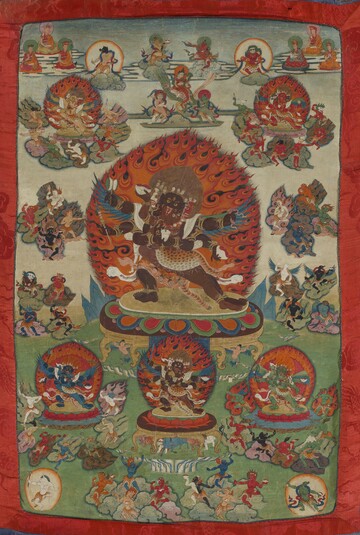
Item: Mahottara Heruka (Buddhist Deity) - (3 Faces)
| Origin Location | Tibet |
|---|---|
| Date Range | 1700 - 1799 |
| Lineages | Nyingma and Buddhist |
| Material | Ground Mineral Pigment on Cotton |
| Collection | Private |
Classification: Deity
Appearance: Wrathful
Gender: Male
The Wrathful Deities of the Guhyagarbha Tantra.

At the center of the composition is Mahottara Heruka embracing a consort. At the upper left is Ratna Heruka, yellow in colour. At the upper right is Padma Heruka, red in colour. At the lower center is Buddha Heruka, maroon in colour. At the lower right is Karma Heruka, green in colour. At the lower left is Vajra Heruka, blue in colour.
Accompanying Mahottara and the Five Herukas and consorts are the attendant and retinue deities.
Fifty-eight Wrathful Deities:
1. Five Male & Female Herukas (10)
2. Eight Yoginis (8)
3. Eight 'Tramen' (amalgamated deities) (8)
4. Four Female Gatekeepers (4)
5. Twenty-eight Shavaris (28)
At the top left are three Tibetan teachers. Two can be identified as the Shamarpa and the Karmapa. There are no name inscriptions but they are quite likely to be the 10th Shamar, Chodrub Gyatso (1741/42-1792), and the 13th Karmapa, Dudul Dorje (1733/34-1797/98). On the right side are three additional teachers. Only one can be identified as the 8th Tai Situpa, Chokyi Jungne (1700-1774).
In the Nyingma Tradition the Guhyagarbha Tantra (8th to 10th century) is considered the most important of all Tantras. It describes two basic mandala configurations - one of forty-two peaceful deities and another of fifty-eight wrathful deities - combined they are the One Hundred Peaceful & Wrathful Deities. There is a clear organization and a structured hierarchy in the Tantra and two mandalas. There is also a clear relationship between the deities of the Guhyagarbha Tantra and the various Tibetan Buddhist traditions of the Bardo Todal (Tibetan Book of the Dead). The forty-two peaceful and fifty-eight wrathful deities are the basis for the iconography depicting the subject of the 'Bardo' - Tibetan Book of the Dead. The 'Terton' Karma Lingpa, in the 14th century, is credited with the discovery of the 'treasure text' known as the Liberation Through Hearing in the Bardo, a text intended to be read to the deceased with the wish to influence positively the subsequent rebirth.
Jeff Watt 1-2014
Buddhist Deity: Mahottara Heruka (Chemchog)
Subject: Guhyagarbha Tantra (Peaceful & Wrathful Deities)

